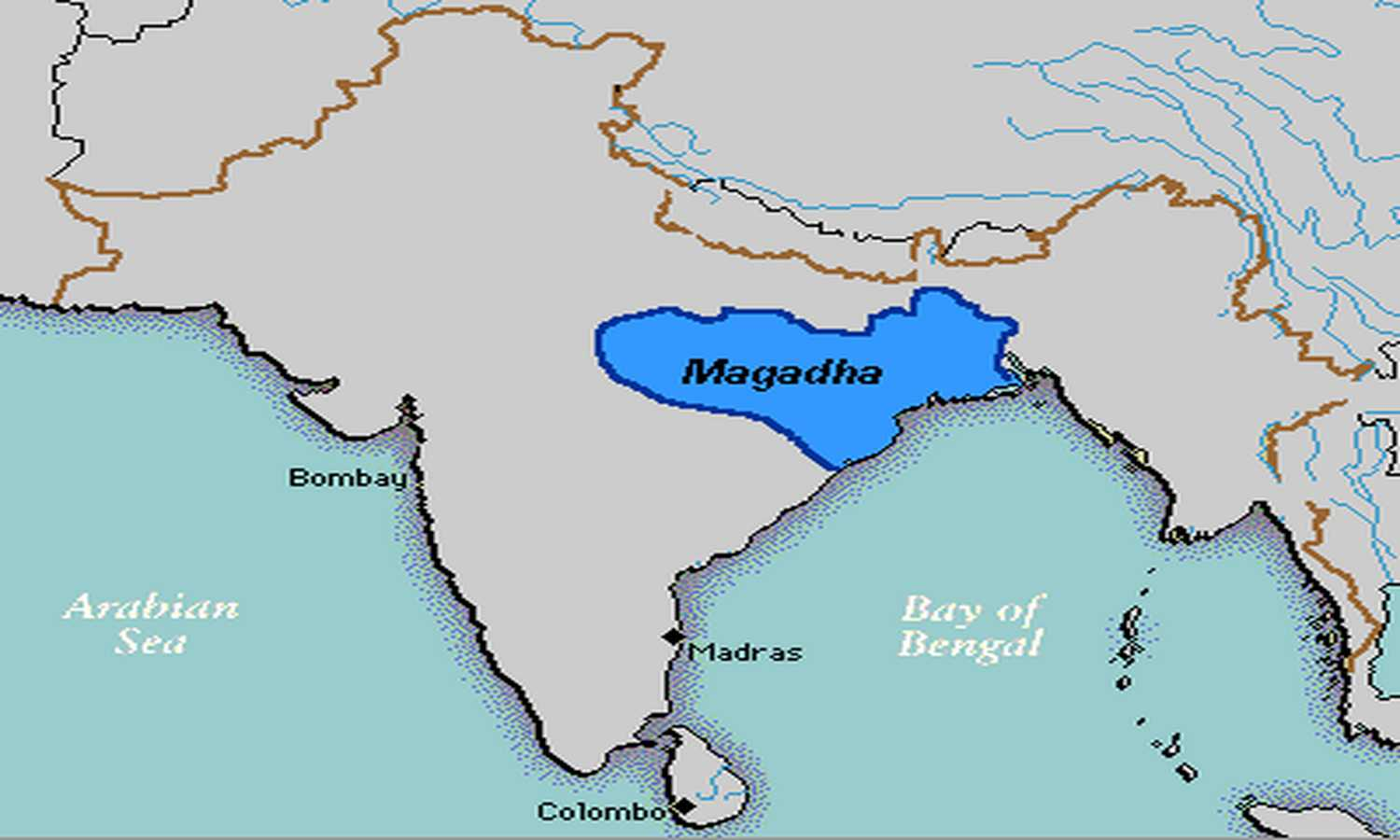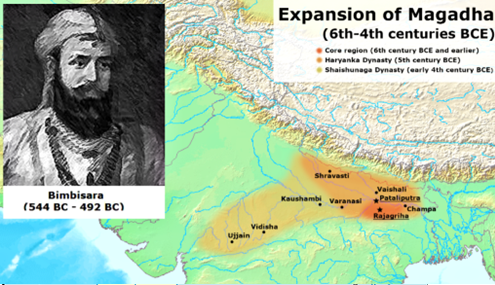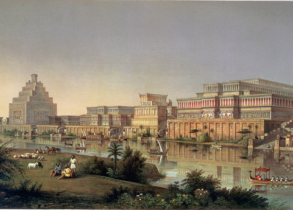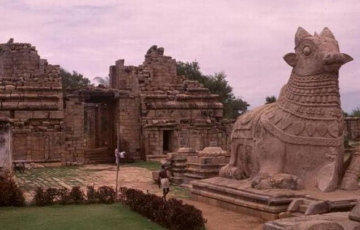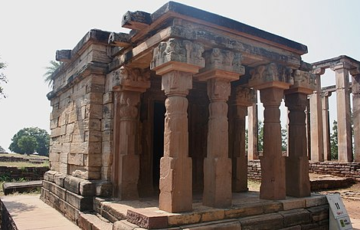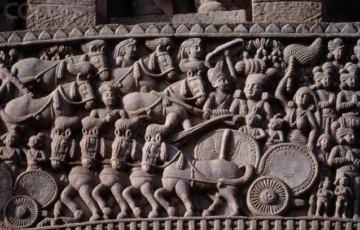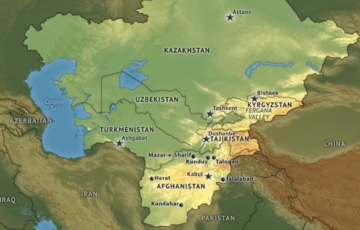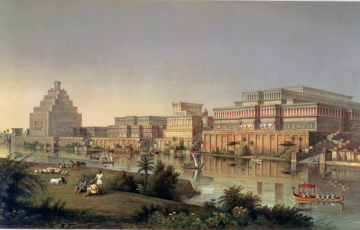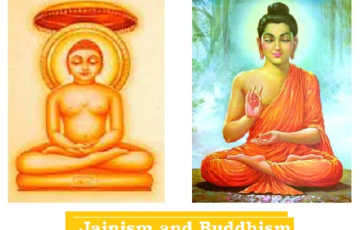MAGADH EMPIRE
Introduction
The Later Vedic Period (900–600 BC) marked the shift from a tribal lineage-based system (Jana) to territorial states (Janapada).
- Janapadas engaged in conflicts for resources and political supremacy, leading to territorial expansion. Some Janapadas expanded their territories and incorporated various janas under their rule, evolving into Mahajanapadas (large empires).
- Mahajanapadas had either monarchical or republican forms of governance.
- Janapada refers to the land where a group of people, clan, or tribe settles.
| Monarchies | Republics (Gana Sangha) |
| ● Administration centralized under the rule of kings.
● Kingship hereditary, succession based on primogeniture. Decision-making authority vested in the king. ● King assisted by councils like parishad (primarily composed of Brahmins) and sabha for advisory purposes. ● Revenue rights claimed solely by the king. ● Vedic orthodoxy practiced, with Brahmin priests holding a significant status and legitimizing the king through rituals. ● Central standing army under the king’s command. |
● No single decision-making authority.
● Tribal chiefs selected by a larger group. ● Decision-making through collective efforts of clan heads or Rajas. ● Each tribal ruler (Raja) enjoyed revenue rights. ● Influence of the priestly class not prominent. ● Maintained armies under a Senapati (army chief). |
Reasons for Rise of Mahajanapadas
- Favorable geographical positioning: The Ganga plains, endowed with fertile soil and proximity to iron production hubs, played a pivotal role.
- Advancements in iron technology: Improved iron tools revolutionized agriculture, resulting in surplus production crucial for sustaining military and administrative demands, thereby facilitating settlement stability.
- Establishment of administrative hubs: Large states centered their governance in towns, fostering allegiance to the Janapada over individual janas or tribes, thereby promoting unity and cohesion within the state.
Mahajanapadas
- The Buddhist scripture Anguttara Nikaya, found within the Sutta-Pitaka, enumerates these sixteen Mahajanapadas.
- Within the 16 Mahajanapadas, a struggle for power unfolded involving Magadha, Kosala, Vrijji, and This competition ultimately propelled Magadha to the forefront as the most dominant state.
- The ascent of Magadha’s political influence commenced with Bimbisara, a member of the Haryanka dynasty.
| State | Capital | Modern Day Region | Important Features |
| Magadha | Rajagriha or Girivraja | Modern Patna and Gaya | Haryanka Dynasty |
| Anga | Champa
(at confluence of the Ganga & Champa rivers) |
Modern districts of Monghyr and Bhagalpur, Bihar | Merchants departed from Champa, sailing towards Suvarnabhumi in Southeast Asia. |
| Vajji | Vaishali (Modern Basarh in North Bihar) | North of Ganga in the division of Tirhut | Confederacy including Lichchhavis, Jnatrikas, and Vajjis; Mahavira belonged to the Jnatrikas Clan
Important Ruler: King Chetaka |
| Mallas | Kushinara and Pava | Gangetic Plains U.P. | Buddha took his last meal in Pava and attained Mahaparinirvana at Kushinara |
| Kashi | Varanasi U.P. | between Varuna and Assi rivers | Incorporated into Kosala by King Kansa |
| Gandhara | Takshashila | North-western Pakistan | Major center for trade and learning; Conquered by Persians in the later part of the 6th century BC, as per the Behistun Inscription of Emperor Darius |
| Kosala | Sarayu River divides the state into Northern Kosala (Shravasti) and Southern Kosala (Kushavati) | Eastern U.P., including Ayodhya | King: Prasenjit (Buddha’s contemporary);
Lumbini, birthplace of Gautama Buddha within the tribal republic of the Shakyas |
| Ashavaka/ Assaka | Potali | Between the rivers Godavari and Manjira;
Modern Bodhan, district Nizamabad, and parts of Adilabad in Telangana |
Only Mahajanapada situated south of the Vindhya Range in Dakshinapatha |
| Cheti or Chedi | Shuktimati or Sotthivatinagara | Eastern part of Bundelkhand region | King: Shishupala |
| Vatsa | Kaushambi | at the confluence of the Ganga and Yamuna, near Allahabad | King: Udayana; Vatsa known for fine cotton textiles |
| Kuru | Indraprastha | Western U.P. | Mahabharata elaborates on the conflict between two branches of the reigning Kuru clan |
| Panchala | Ganga River divides the state into two parts- Ahichchhatra (Northern Panchala);
Kampilya (Southern Panchala) |
Western U.P. (Bareilly and Farukkhabad) | Kanauj situated in the kingdom of Panchala |
| Matsya | Viratanagara | Jaipur, Alwar, and Bharatpur area of Rajasthan | Founder: Virata |
| Shurasena | Mathura | Braj region in U.P. | King: Avantipura (Disciple of Buddha) |
| Avanti | Divided by the Vindhyas: North Avanti – Ujjain; South Avanti – Mahishmati | Central Malwa | King: Pradyota (Father-in-law of Udayana) |
| Kamboja | Poocha | Rajouri and Hajra (Kashmir) and NWFP of Pakistan | Renowned in ancient times for their exceptional breed of horses and renowned horsemanship, situated in the Uttarapatha or North-West. |
MAGADHA EMPIRE
- The Magadha Empire stood as a significant kingdom during the period known as the second urbanization, spanning from the 6th to the 3rd century BC.
- Key ruling dynasties of the Magadha region included the Haryanka, Shishunaga, and Nanda.
- The rise of towns in the Gangetic plains during this era was fueled by factors such as agricultural surplus, the expansion of crafts and trade, and a burgeoning population.
- This period marked the second phase of urbanization in Indian history, distinct from the First urbanization observed in the Harappan Civilization.
Sources to study Magadha
- Vedic texts, including Brahmanas and Upanishads, offer insights into various Janapadas and Mahajanapadas.
- Buddhist scriptures such as the Vinaya Pitaka, Sutta Pitaka, and Abhidhamma Pitaka provide valuable information regarding ancient states.
- Jainism text Bhagawati Sutra furnishes a list of Mahajanapadas from that historical period.
- Archaeological findings, notably Northern Black Polished Ware (NBPW) pottery, offer tangible evidence of ancient civilizations.
- Discoveries of archaeological remnants in sites like Ahichchhatra, Hastinapur, Kausambi, Ujjaini, among others, contribute significantly to understanding the historical landscape.
Haryanka Dynasty
This Dynasty marked the inaugural reign over Magadha, establishing its capital in Rajagriha.
- While the identity of the dynasty’s founder remains uncertain, most scholars attribute this position to the grandfather of Bimbisara.
| Bimbisara (544-492 BC) | ● Contemporary of Buddha and Mahavira.
● Conflicts: o Initially rivaled Avanti’s king, Pradyota, but later formed an alliance; sent his physician Jivaka to aid Pradyota. o Conquered Anga by defeating Brahmadatta, securing vital trade routes. ● Strengthened his position through matrimonial alliances: o Married Mahakoshala, sister of Prasenjit, gaining Kashi as dowry. o Married Lichchhavi Princess Chellana, mother of Ajatashatru. o Married the daughter of the Madra clan chief from Punjab. ● Assassinated, succeeded by his son Ajatashatru. |
| Ajatashatru (492-460 BC) | ● Implemented expansionist policies through military conquest.
● Conflicts: o Annexed Kosala and retained Kashi by defeating Prasenjit. o Annexed Vaishali by defeating his maternal grandfather, Chetak. o Defeated the Mallas. ● Employed military weapons such as catapults (Mahashilakantaka) and chariots with maces (Rathamusala). ● Fortified Rajgriha against potential invasion by Avanti. ● Met Buddha; arranged the first Buddhist council upon Buddha’s Parinirvana. ● Succeeded by his son Udayin. |
| Udayabhadra (Udayin) (460-444 BC) | Founded the new capital at Pataliputra, located at the confluence of the Ganga and Son rivers. |
Shishunaga Dynasty (413- 345 BC)
| Shishunaga | ● Initially serving as an Amatya or “minister” under Nagadasaka, the last ruler of the Haryanka dynasty, Shishunaga established his own dynasty in 413 BC.
● He temporarily relocated the capital to Vaishali during his reign. ● He achieved victory over Avanti, integrating it into Magadha and ending the century-old rivalry between the two kingdoms. ● His son, Kalasoka, succeeded him. |
| Kalasoka | He was also known as Kakarvarna according to the Puranas, hosted the Second Buddhist Council at Vaishali. |
| Mahapadma Nanda | He seized power by assassinating the final king of the Shishunaga dynasty. |
Nanda Dynasty (345 – 321 BC)
| Mahapadma Nanda | ● He was also known as Ugrasena due to his formidable army.
● Lineage: Brahmanical texts suggest he hailed from a non-Kshatriya caste, while Buddhist texts place the Nandas in the Annatakula, of unknown lineage. ● He was India’s first empire builder, boasting the title of Ekarat (sole sovereign who vanquished all other ruling princes) and Sarva-kshatrantaka (destroyer of Kshatriyas). ● He expanded Magadha’s territory by annexing Kalinga, bringing back a Jina image as a symbol of victory, and subdued rebellions in Kosala. ● Taxes: He implemented systematic tax collection through appointed officials, crucial for sustaining a large military force. ● Irrigation: He initiated irrigation projects, constructing canals to enhance agricultural productivity. ● His reign ended with the succession of his eight sons, collectively referred to as the Navanandas or the nine Nandas. ● Hathigumpha (elephant cave) inscription at Udayagiri near Bhubaneshwar, Odisha, documented the construction of an aqueduct by Mahapadma Nanda. |
| Dhana Nanda | ● He was the last prominent ruler, commanding a massive army and earning the epithets Agrammes or Xandrames according to Diodorus, the Greek historian.
● He is attributed with creating the Nandopakramani, a specific measuring standard. ● His reign coincided with Alexander the Great’s invasion of northwest India from 327 to 325 BC. |
Causes of Magadha’s Success:
- Ambitious rulers like Bimbisara, Ajatashatru, and Mahapadma Nanda employed both diplomatic and military strategies to expand the empire.
- Geographical Advantages: Magadha’s access to abundant iron ore facilitated the production of effective weaponry.
- Strategic locations of Magadha’s capitals, Rajgir and later Pataliputra, contributed to their military and administrative prowess.
- Rajgir, encircled by five hills, was highly defensible.
- Pataliputra’s positioning among rivers allowed it to function as a water fort (Jala Durga), enhancing its defensive capabilities.
- Central Position in Gangetic Plains: Southern forests provided timber and elephants, granting Magadha a military advantage.
- Magadha pioneered the large-scale use of elephants in warfare against neighboring states.
- Timber resources facilitated boat construction, facilitating Magadha’s expansion efforts.
Administration under Magadhas
Officials and Ministers:
- Higher officials, known as Mahamatras/Amatyas, held multiple roles including ministers (mantrin), commanders (Senanayaka), judges, chief accountants, and heads of the royal harem, assisted by
- They were typically recruited from the Brahmanas and wielded significant authority.
- The Mahaparinibbana Sutta, a Buddhist text, mentions Vassakara of Magadha, who played a key role in Ajatashatru’s conquest of the GanaSangha of Vajjis.
Laws and Regulations:
- Legal and judicial systems superseded tribal laws.
- Social hierarchy influenced civil and criminal laws, with crimes committed by Shudras against upper varnas being severely punished, while those against Shudras were treated more leniently.
- Royal agents administered law based on the Dharmashastras, with punishments for criminal offences including scourging, beheading, and others.
Society
- The society was structured into four varnas: Brahmanas, Kshatriyas, Vaishyas, and Shudras.
- Shudras were marginalized from high positions and typically occupied roles as slaves, artisans, and agricultural laborers.
- A new social category emerged known as untouchables, positioned below the Shudras in the hierarchy.
- Untouchables were relegated to living on the outskirts of settlements, relying on hunting and gathering for sustenance.
- They faced marginalization and were assigned only menial tasks.
- Untouchables had their own distinct language, differing from that spoken by the Indo-Aryans.
Family Relations
- Kinship ties were highly valued and integrated into the caste hierarchy.
- Kula represented the extended patrilineal family, while Natakas encompassed both maternal and paternal relatives.
- Extended kin groups were known as Nati and Nati-Kulani.
Status of Women
The society was patriarchal, with women holding inferior status.
- The endogamous caste system further marginalized women.
- Preference for sons persisted, as they were deemed essential for lineage continuation and performing funerary rites.
Economy under the Magadha Empire
Towns and Cities
- The agricultural surplus, growth of crafts and trade, and increasing population contributed to the emergence of towns in the Gangetic plains, known as the second urbanization.
- Towns were categorized as Pura or Nagara (fortified town or city), Nagarka (small town), and Nigama (market town).
- Various types of towns developed:
- Political and administrative centers like Rajgriha, Shravasti, Kaushambi, and Champa.
- Centers of trade and commerce such as Ujjain and Taxila.
- Holy centers like
Village Settlement
The Pali texts, particularly the Vinay Pitaka, outline three types of villages (grama)
- Typical villages: Inhabited by diverse caste communities and led by Gramabhojaka, Gramini, or Gramakas.
- Suburban villages (craft villages): Specialized settlements like Carpenter’s village (Vaddhaki-grama), Reedmaker’s village (Nalakaragrama), and Saltmaker’s village (Lonakara-grama).
- Border villages (Aramika-grama).
Trade and Transportation
- Towns were strategically positioned along riverbanks and trade routes.
- Two major trans-regional routes were:
- Uttarapatha: Running from the northwest across the Indo-Gangetic plains to the port city of Tamralipti on the Bay of Bengal.
- Dakshinapatha: Stretching from Pataliputra in Magadha to Pratishthana on the Godavari, linked to ports on the western coast.
- Maritime trade was also prominent:
- Eastern regions engaged in trade between Bengal and Myanmar.
- Western regions, like Taxila, had trade ties with Afghanistan, Iran, and Mesopotamia.
- Rajabhatas were royal officials tasked with protecting the lives and property of travelers.
- Imported items included gold, lapis lazuli, jade, and silver, while exports comprised finished crafts, textile goods, sandalwood, pearls,
- The use of money is evident:
- Panini’s Ashtadhyayi mentions wages (Vetan) and wage-earners (Vaitanika), indicating monetary transactions.
- The earliest coins were punch-marked, made of silver and copper, and issued around the 6th century BC by the Mahajanapadas.
Taxation
- Taxes were collected in both cash and kind.
- Warriors (Kshatriya) and Priests (Brahmana) were exempt from taxes, with the burden primarily on the peasant class, mainly Vaishyas or
- Bali, a compulsory tax, required peasants to pay one-sixth of their produce.
- Typically, there were no intermediaries between peasants and the state.
- Royal agents (Balisadhakas), often assisted by village headmen, assessed and collected taxes.
- Peasants were obligated to provide forced labor for royal projects, while artisans were required to work one day each month for the king.
- Kammikas (customs officials) and Shaulkika/Shulkadhyaksha (toll officials) imposed taxes on merchandise.
- Some villages were granted to Brahmanas (Brahmadeyas) and Setthis (big merchants), who had revenue authority without administrative control over these villages.
Agriculture
- Agriculture was the primary economic activity in villages.
- Introduction of paddy transplantation and the use of iron ploughshares significantly boosted yields, with rice being the staple cereal. Other crops included barley, pulses, millets, cotton, and sugarcane.
- Grihapatis (wealthy landlords) employed laborers known as Dasas or Karmakaras, while smaller landowners were called Kassakas or Krishakas.
- Iron tools played a vital role in cultivating forested and hard soil areas of the mid-Gangetic basin, with iron implements discovered in places like
- Access to abundant iron mines like those in Mayurbhanj and Singhbhum ensured a steady supply of tools.
Guild System
- The Guild system fostered craft specialization, with guilds led by a headman, often passed down
- Artisans and merchants resided in fixed localities within towns, with the main merchant street known as ‘Vessa’.
Iranian Invasion
- In the 6th century BC, the fertile land and abundant natural resources of the Indian subcontinent attracted invaders from the northwest.
- Weak leadership and political disunity among small principalities like Kambojas and Gandharas led to minimal resistance against the invaders, who traversed the Hindu Kush mountains to penetrate the region.
Achaemenian/Iranian Invasion:
- The Achaemenid king Cyrus (558–529 BC) led the first invasion of the subcontinent.
- Later, Persian king Darius annexed the Punjab in 516 BC, bringing the northwest Indian subcontinent under Iranian rule until Alexander the Great’s invasion.
- Takshashila (Taxila) was part of the Achaemenid Empire
- It was excavated in the 1940s by Sir John Marshall.
- Panini, during the 6th to 5th century BC, compiled his renowned work, Ashtadhyayi, in Taxila.
Results of Indo-Iranian Contact
Indo-Iranian contact, spanning almost two centuries, yielded both economic and cultural impacts. Greeks learned about India’s wealth through Iranians, contributing to Alexander’s invasion of India.
Economic Impacts:
- Trade and commerce flourished between the regions, as evidenced by the discovery of Persian coins in the North West Frontier Province
- Persian sigloi, silver coins, were imitations from Persia, indicating economic interactions.
- The Indian word for coin, karsa, has Persian origins, suggesting influence from Persian coins.
Cultural Impacts:
- Introduction of the Kharoshthi script, derived from Aramaic, the official script of the Persian Empire, which is evident in Ashoka’s rock edicts.
- Iranian artistic and architectural influences are seen in Mauryan sculpture, notably in Ashoka’s bell-shaped capitals like the Lion capital of Sarnath and Bull capital of Rampurva pillars.
- Specific terms and phrases in Ashoka’s edicts reflect Iranian influence, such as the use of ‘lipi’ for the Iranian term ‘dipi.’
Linguistic similarities between Rig Veda and Avesta:
- According to Indologist Thomas Burrow, linguistic changes over time have primarily been phonetic.
- The Bogaz Koi Inscription, dating back to 1380 BC, records a treaty between a Hittite and a Mitanni King, mentioning names of Rig Vedic gods like Indara, Uruvna (Varuna), Mitira, and Nasatiya (Ashvins).
| ALEXANDER’S INVASION OF INDIA (327-326 BC)
Reason for Invasion: ● Greek-Iranian Conflict: In the 4th century BC, Greeks and Persians vied for world supremacy. After defeating the Persian army, Alexander marched towards India. ● Disunity in North-West India: The region was divided into numerous independent monarchies and tribal republics, leaving the Khyber Pass unguarded and accessible to invaders. ● Wealth of India: as described by Greek writers like Herodotus. Alexander’s Campaign: ● He entered India in 326 BC, crossing the Khyber Pass. The Jhelum River marked the first resistance from Porus, an Indian prince. ○ Despite defeating Porus in the Battle of Hydaspes, Alexander was impressed by his valor and restored his kingdom. ○ He proceeded eastward to the Beas River but faced opposition from his army due to various factors, forcing him to retreat. ● His retreat ended his dream of an eastern empire, and he died of typhoid during his return in Babylon. Effects of Alexander’s Invasion: ● Political: Establishment of Greek satrapies in northwestern India, increased Greek settlements, and weakened small states, paving the way for the Mauryan Empire’s expansion. ○ For example, cities like Alexandria existed in the Sindh and Kabul region, while Boukephala was established on the Jhelum River, known today as Peshawar in Pakistan. ● Trade and Communication: Direct contact between ancient Europe and South Asia, opening up four distinct routes—three by land and one by sea. ● Cultural development: Establishment of the Gandhara school of arts. |
UPSC PREVIOUS YEAR QUESTIONS
1. Which of the following Kingdoms were associated with the life of the Buddha? [UPSC CSE 2014]
1. Avanti
2. Gandhara
3. Kosala
4. Magadha
Select the correct answer using the code given below.
a) 1, 2 and 3
b) 2 and 4
c) 3 and 4 only
d) 1, 3 and 4
2. In which one of the following regions was Dhanyakataka, which flourished as A prominent Buddhist centre under the Mahasanghikas, located? [UPSC CSE 2023]
1. Andhra
2. Gandhara
3. Kalinga
4. Magadha
3. With reference to the cultural history of India, the memorizing of Chronicles, dynastic histories, and epic tales was the profession of who of the following? [UPSC CSE 2016]
1. Shramana
2. Parivraajaka
3. Agrahaarika
4. Maagadha
| IMPORTANT FACTS RELATED TO THE CHAPTER
● Aahat coins, also known as Punch marked coins, were the earliest silver coins in India, bearing marks made by stamping. ● The Pali scriptures mention Pradyot as the king of Avanti, Udayana as the king of Vatsa Mahajanpada, Prasenjit as the king of Kosal, and Ajatshatru as the king of Magadha. ● The legend of Udayan-Vasavadatta, portrayed in the drama “Svapnavasvadattam” by Bhaas, revolves around the love story of Vatsa king Udayan and Vasvadatta, daughter of Avanti King Pradyot, during Udayan’s imprisonment in Ujjayini. ● Various republics existed during the time of Buddha, including Shakya, Bhagga, Buli, Kalam, Koliya, Malla, Moriya, Lichchhavi, and Videha. ● The Lichchhavi dynasty of Vaishali established the first republic in the world, with King Chetak being one of its prominent rulers. ● Shravasti, identified by Alexander Cunningham at Sahet-Mahet, was an ancient city known for its crescentic configuration. ● The Nanda dynasty of Magadha, succeeding the Shishunaga dynasty, consisted of nine kings, with Chandragupta Maurya eventually overthrowing Dhanananda to establish the Maurya Empire. ● Kharvel, a significant ruler of the Chedi dynasty of Kalinga, is best known through his Hathigumpha inscription, which mentions his victories and the engraving of canals in Kalinga. |

